Snowkiting Montana
It can’t get any better!
In the winter Montana is a cold, snowy state with abundant wind. With the arrival of the first snow storms, through the cold smoke of January, finishing with the warm and sunny, granular corn of May (and often June), snowkiting in Montana is reliably an eight-month long season.

Many are learning that Montana is perfectly suited for snowkiting. With help from the jet stream, the pressure gradient along the spine of the Rocky Mountains creates a giant wind machine. While some areas have too much wind (and too little snow cover), the vast majority of Montana kite spots have the right combination of deep snow and strong wind. Conveniently, automated weather stations provide up-to-the-minute reporting to help kiters make the daily decision on where to session. Friendly locals help out by routinely giving permission to kite on their private land.

Montana farmers and ranchers are some of the most obliging people I’ve ever met. Ninety-nine percent of the time whenever I’ve asked, “Can I fly my kite on your land”, the answer is a disinterested “It don’t bother me none.” However, once they see the size of our kites, the fact that we’re on skis and snowboards, the ripping speeds and the huge boosts, they are no longer disinterested. They will sit in their warm pickup truck or at their living room window and find the spectacle of snowkiting irresistible. After tracking out their ranch they are only too happy to tell you about the neighbor’s land or where it’s really deep and windy. In addition to the occasional beer, I’ve had ranchers offer their snowmobiles for better access to the high-country.
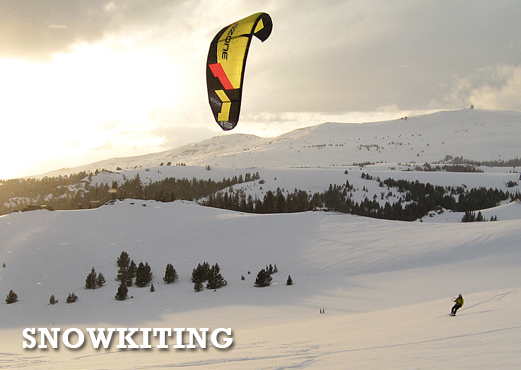
Snowkite pioneering in the northern Rockies has moved from its infancy into energized adolescence. In the early years of the last decade, local kiters started in rolling farm fields, ranch land, and snow-covered lakes. As kiters began to look around and visit new areas, the number of choice kite spots exploded. With over a decade of winters behind them, Montana snowkiters have amassed an impressive cache of world-class kite locations. For the increasing numbers of kiters who chase the wind all winter, the experience grows larger and larger each year.

The list of choice riding locations has developed with the sport. Whether one wants to freestyle in natural terrain parks, shred wild backcountry ridges and bowls atop the Continental Divide, or kite laps on gentle hillsides of untracked powder, it’s all here. Still yet, there are many more new kite spots that await discovery.
My winter mornings in Bozeman follow a predictable pattern: surf a couple dozen weather links on the Web, power down a double espresso, make a lunch, and hit the road for a day of snowkiting. Some sessions can be five minutes’ drive from my home; others may require a two-hour drive.
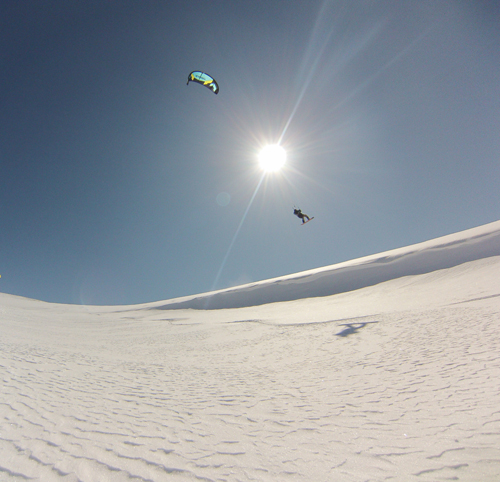
As I drive south on Montana Highway 87 and approach Raynolds Pass, I see a huge roiling cloud suspended and dumping snow at a favorite destination on the Continental Divide. A mile before I arrive at the Pass it’s nuking.
I can barely contain myself. I say, “O.K., stay calm, you’ll be there soon.” Sure enough, at the Pass the wind is howling. A fusillade of flakes pummels me as I leave my warm truck. It’s blowing 25 – 35 and there is three feet of dry fluff all around. While the wind speed suggests an 8m kite, I know I’ll need more size as the snow is so deep. I grab my biggest kite, a 13m Ozone Frenzy. Launched and flying,
I revel in the snow’s depth and the softness of the experience. For me, kiting in deep powder, hanging on in the gusts, and gouging bottomless lines during the 25 mph lulls is a feeling like none other.

Boosting off corniced wind lips with soft white-out landings seems like a dream. Dropping top to bottom lines of untracked again and again it feels as if I’m cheating as the wind-powered ride doesn’t stop. As the hours of kiting pass, I eventually become fatigued. I finally retreat to the cold confines of my truck. After a quick break and some food, I’m out the door again to finish my day with a sunset session of more fresh powder at Raynolds Pass.
Kiting Raynolds Pass at sunset, the light is sublime. It penetrates and filters through the wind driven flakes as the storm eases towards nightfall. I squeeze out every bit of light and end up packing away my kite and skis after dark. Exhausted, I drive to a motel in West Yellowstone. On the way I pass two untracked kite spots on a private ranch. The snow conditions are perfect and tomorrow will bring another windy and bottomless day of kiting the cold-smoke.
This is the reality of the Montana Rockies that I love: day after day of unbeatable snow and terrain, reliable wind and only the tracks of you and your friends. In time I’m sure that it will change as more and more people discover the wonder of snowkiting here. I also know that the Northern Rockies offer a huge world of choices; after all,
it’s a big place. For years to come I suspect that Montana snowkiters will continue to ask: “Can it get any better?”
GEAR
Snowkiters use a large nylon wing, between 6 to 15 square meters in size, to pull oneself on skis or a snowboard across the snow covered landscape. Kiters use a harness to attach themselves to the kite lines and are able to control the power of the wing through precise kite flying and by sheeting the kite’s control bar: sheet in for more power, sheet out to spill the wind’s power. Choosing what size kite to fly is determined by wind speed, snow depth, the rider’s weight and their experience. High winds and harder snow: choose a smaller kite. Deep snow and lighter wind means a larger kite. Most kiters have a quiver of two or three kites to ensure they have the right size for the day’s conditions.
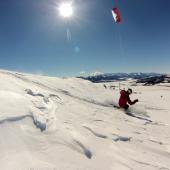
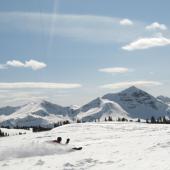

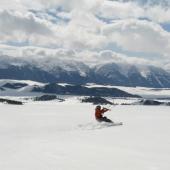
Most of one’s time snowkiting is spent cruising around on the snow. Going uphill, downhill, and across terrain features is the more meditative aspect of snowkiting. Enjoy the scenery and marvel at the wind-powered ride. However, because the kite is so very powerful, one can easily boost off the snow and immerse oneself in intense sessions of pure aerial freestyle. Front rolls, back rolls, sky-high boosts, and long floaty glides quickly become part of a kiter’s adrenaline-filled airborne repertoire. Snowkiting imports skills from many sports and synergizes them into a new realm of personal wonder and amazement.
MONTANA SNOWKITE GEOGRAPHY
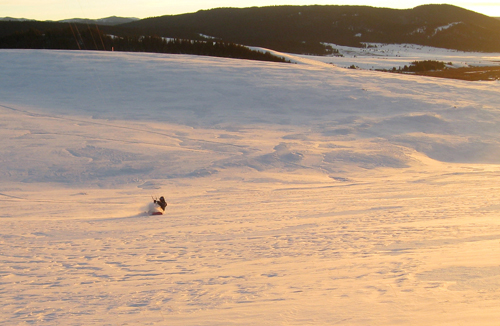
Snowkiting in Montana (including parts of nearby Idaho and Wyoming) is second to none. On the western edge lies Mount Haggin, at the head of the Big Hole Valley. With over 10 square miles of windy flats and hilly terrain features, Haggin is a gem worth visiting. Also nearby are the beginner friendly expanses of snow-covered Georgetown Lake. At the southern end of the Big Hole is the tiny town of Jackson. Jackson Hot Springs will host the 12th annual Montana Snowkite Rodeo, February 13th – 16th 2015.
Looking east, there are a half a dozen local kite spots near Bozeman some of which are literally right on the edge of town. An hour’s drive to the north is Canyon Ferry Lake, arguably some of the best iceboating anywhere but also for ice kiting on skates. Farther north, by Helena, are the perpetually windy passes: Mullen and MacDonald.
In the South find the snowmobile-access kite spots near the Gravelly Mountains and the Madison Range. Further south is the park-n-ride fun of Raynolds Pass.
East again and straddling Montana and Wyoming is the Beartooth Plateau, the largest alpine plateau in the United States. For those who have the skills, the Beartooth rivals any kite spot in the United States for huge, expansive terrain. The deep snow, towering cornices, and reliable winds of the Beartooth Mountains make for a jaw-dropping snowkite experience.
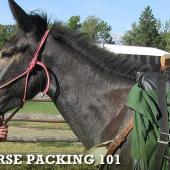
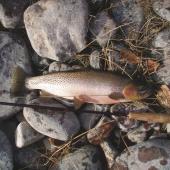


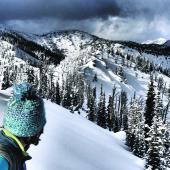
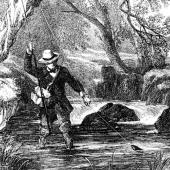
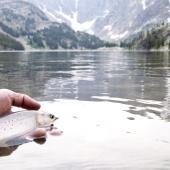
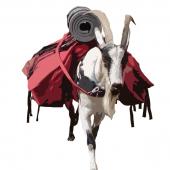
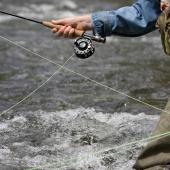
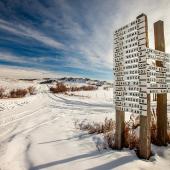
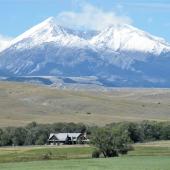

Leave a Comment Here